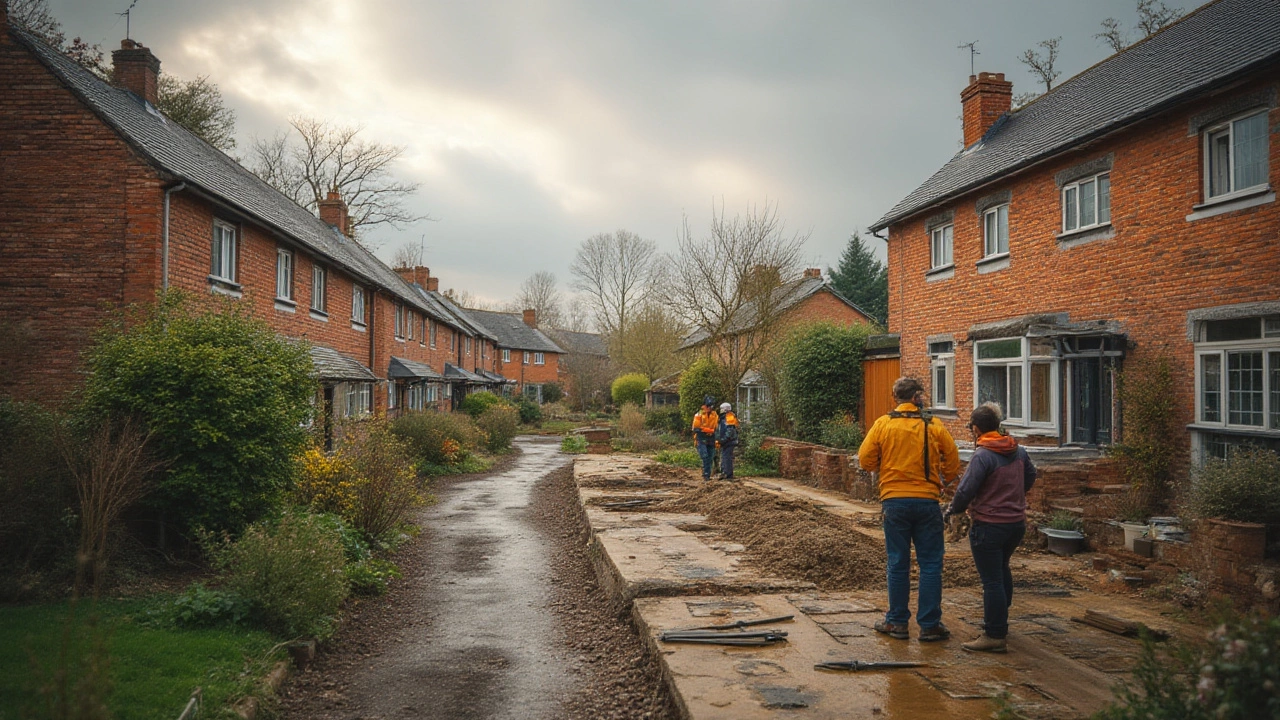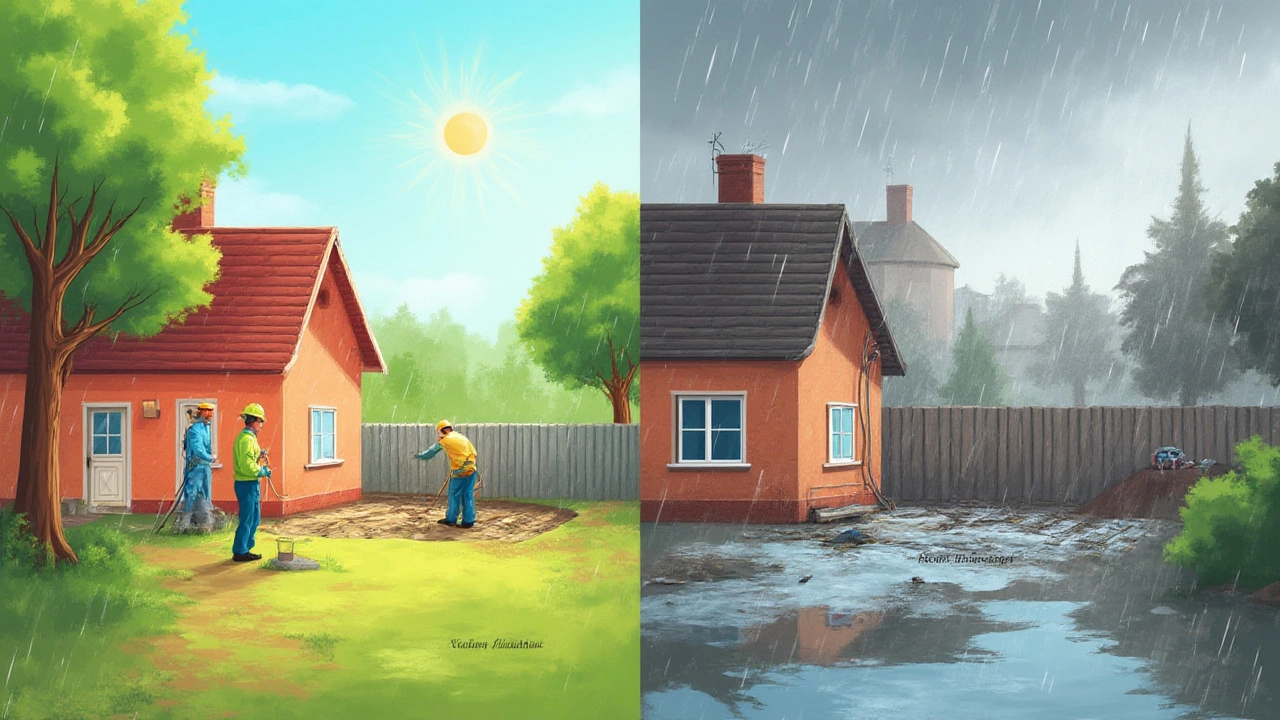
Ever noticed cracks zigzagging up your walls or the basement feeling a bit spongy underfoot? It's the stuff of homeowner nightmares—a shifting, sinking foundation. Most people don't think about their home's foundation until something looks or feels off, but the timing of foundation repair can make a massive difference. Weather changes, soil moisture, and even how busy contractors are can play huge roles in not just the quality of the repairs, but also how much you pay and how long disruptions last. If you've got foundation issues, knowing exactly when to call in the professionals can save cash, hassle, and even prevent long-term headaches.
How Weather and Seasons Affect Foundation Problems
Let’s get one thing straight: the soil around your house moves—sometimes a lot. The moment you pour a foundation, Mother Nature starts testing it. In regions with clay-heavy soils, the ground swells up when it rains and contracts as it dries. All this push and pull can leave your foundation stressed out. In the U.S., nearly 60% of homes are built on soils that shift, according to the American Society of Civil Engineers. That sounds like a big number, but when you think about Texas, Oklahoma, or parts of Georgia with their infamous clay, it’s easy to see why foundation repair is a booming industry.
Weather isn’t just about rain or sunshine—it’s about temperature swings and humidity that change the soil’s moisture content. During the spring, when rains return after a dry winter, the ground can move yet again, sometimes causing fresh cracks or issues that weren’t there a month ago. But summer is usually when soil dries out the most, drawing away from the foundation and sometimes creating gaps. In winter, freezing and thawing can heave the soil, so homes in Northern states might see more movement during cold snaps than those in the South. Dry spells in late summer, especially after a rainy spring, are notorious for making cracks look worse; the ground pulls away, foundation sags, doors stick, and pipes groan.
What’s wild is that even trees make a big difference. Large trees near the house can drink up gallons of water a day, shrinking the soil further around your foundation and putting even more pressure on the structure. According to physical geographer Dr. Tom Parry, the area from the trunk to the edge of the branches is the "critical root zone," and that's exactly where soil dryness peaks in dry months. So, even landscaping choices play into the seasonal shifts.
Check out this table for how these weather swings impact foundations in different regions:
| Season | Typical Soil Condition | Common Foundation Issues | Region Most Affected |
|---|---|---|---|
| Spring | Soil expanding after winter rains | New cracks; doors/windows jam | Midwest, South |
| Summer | Dry, shrinking soil | Foundation settling, gaps, larger cracks | Texas, Oklahoma, Southeast |
| Fall | Stabilizing moisture | Crack monitoring; less movement | Nationwide |
| Winter | Freezing/thawing, possible soil heaving | Vertical cracks, uneven floors | Northern U.S. |
The weather patterns in your zip code decide how much you’ll wrestle with shifting foundations, but the timing of repairs can soften the blow. So, when IS the sweet spot for getting that foundational fix?

Pros and Cons of Each Season for Foundation Repair
If you're hunting for the perfect window to fix foundation problems, the honest answer is: it depends on your climate and schedule. Let’s break down what each season brings to the table so you can plan like a pro—not just play defense when a crack crawls up your living room wall.
Spring: Spring is when most folks first notice cracks or problems—the weather warms up, rain falls, and expansion causes misalignments to pop up, sometimes seemingly overnight. The soil is freshly saturated, so any shifting is likely to be revealed. However, contractors tend to book up fast as everyone rushes to get repairs after the winter. Muddy, wet ground can also slow projects, making it tough for heavy equipment to maneuver. If you get in early (like March or April), you might get lucky before their schedules fill. Just be prepared for unpredictable weather delays.
Summer: When July and August roll around, the ground starts to dry and shrink. Believe it or not, foundation repair is easiest when the soil is more stable and dry, especially for major projects like piering or slab work. Contractors can move faster because there’s less mud to deal with. Plus, you’re more likely to get on their schedule as many homeowners are on vacation or away. But if you wait too long into late summer, extra-dry soil can actually cause further settlement—sometimes right while repairs are underway. If temps soar, working conditions get rough, and materials can cure too quickly or unevenly.
Fall: This is usually the golden zone, especially in the southern half of the country. The ground isn’t as soggy as spring but not quite bone-dry like late summer. Contractors often have more open schedules as the "rush" dies down, and materials perform better with steadier temperatures. The soil is typically the most stable from September to November, so foundation work tends to last longer and stay level. Some pros even say repairs done in November will stand the test of time best, since the foundation isn’t about to experience the dramatic shifts of an upcoming season.
Winter: If you’re up north, winter repairs can be a challenge. Frozen ground is tough to dig, and snowstorms can cause endless delays. Foundations can shift unpredictably when the ground thaws, which may mess with the accuracy of repairs. In the south, milder winters may make work possible, but heavy rain can still muddy things up. One upside? Contractors aren’t as busy, so you might negotiate a better rate or find more flexible scheduling.
When it comes to costs, supply and demand hit hard. According to a 2024 survey of U.S. foundation contractors, repair prices are on average 10-15% lower in the fall than in peak springtime or midsummer, especially in suburban areas where seasonal business swings are sharp. Here are some quick tips to make use of timing to get the best results and maybe keep a little more money in your wallet:
- Book early (even in winter or late fall) to lock in the best dates and prices for the prime repair seasons.
- If you see new or worsening cracks in late summer or early fall, act fast—avoiding a wait can mean much less extensive (and expensive) repairs.
- If you’re in a region that gets hit with big rainstorms, check after spring downpours to catch problems early.
- Regularly monitor any shifting or settling after major weather events so you can time repairs for a period when the soil is most stable (often late fall).
There’s never a "perfect" month that works everywhere. But for most regions, fall really is your best friend—mild temperatures, more stable ground, and a better shot at getting on a contractor’s calendar before holiday schedules and winter slowdowns.

Expert Strategies for Preparing and Scheduling Repairs
Sure, a lot of foundation repair feels reactive—you see a problem, you panic, you call the first number that pops up online. But if you flip the script and do a little planning, you’ll not only spare yourself stress, but you’ll often get a better fix for the long haul. Here’s what pros recommend, based on hundreds of repair projects from dry Texas summers to icy Chicago winters.
1. Identify the Real Problem
Don’t just fix what you see. Almost half of homeowners only notice an issue when it’s already spread or gotten severe. But hiring a structural engineer or a foundation specialist to do a thorough inspection, including under the house, can pinpoint root causes—like leaky drains, gutter overflow, or even a thirsty backyard oak tree. If water runoff is the villain, they’ll spot it. Catching trouble spots early (and knowing what to fix first) is a game changer and saves serious money.
2. Track Soil and Weather Patterns
Grab a notebook or use your phone’s notes to record when cracks appear, doors start sticking, or floors dip. Compare this with local weather data. If you notice the same issues coming back after wet springs or dry summers, that’s your clue for when your foundation acts up. This info helps pros give better advice and can help you time repairs for when the soil is most stable. You’ll be ahead of your neighbors just by keeping a simple log.
3. Prep the Work Area Smartly
Clearing out landscaping, moving patio furniture or pulling up garden beds might sound like a pain, but it can speed up repairs—and even cut down labor costs. Contractors love when they can get straight to work without dodging obstacles. Turn sprinklers off a few days before work, especially in the summer or early fall, to keep the ground at its typical dryness so there are no surprises when digging starts. If rain is in the forecast, covering the work zone with tarps in advance saves time and protects against delays.
4. Ask About Different Repair Options
There’s no one-size-fits-all solution. In the South, you might need piers driven deep into the clay; in the North, foam injections or helical anchors could do the trick. Scheduling a consult in fall means you can get the most accurate recommendation for your specific soil and weather profile, without the rush of contractors juggling multiple emergency jobs. Also, don't forget to discuss timelines and how quickly repairs can happen—sometimes, acting sooner can literally save your house.
5. Compare Contractor Availability and Book Early
It sounds simple, but too many people wait until foundation repair season peaks—usually spring and early summer. If you’re proactive and contact pros in late winter or early fall, you’ll have more choices. Some companies even offer early-bird or off-season discounts. Ask about warranty coverage too. Most offer guarantees, but the best warranties are from companies with years in your area. See who’s used their services in your neighborhood; local reputation is gold in this business.
6. Don’t Ignore Regular Maintenance
It’s boring, but basic things like cleaning gutters, ensuring soil slopes away from the home, and actually watering your foundation with a soaker hose in dry months keeps small problems from becoming massive. Foundation repair pros will tell you—more than half of major foundation jobs could have been prevented by simple maintenance routines caught early.
If you really want to get the most out of your foundation repair investment, just remember: knowledge is power, and timing is everything. The foundation repair experts all agree that when you fix matters just as much as what you fix. Keep an eye on your home, schedule repairs when the soil’s stable, and don’t be afraid to ask questions. You’ll save cash, avoid unnecessary stress, and—maybe best of all—keep your home’s floors level, no matter what the weather throws your way.




